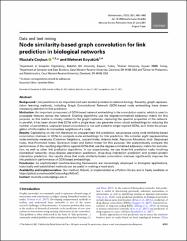| dc.contributor.author | Coskun, Mustafa | |
| dc.contributor.author | Koyuturk, Mehmet | |
| dc.date.accessioned | 2022-02-27T09:51:44Z | |
| dc.date.available | 2022-02-27T09:51:44Z | |
| dc.date.issued | 2021 | en_US |
| dc.identifier.issn | 1367-4803 | |
| dc.identifier.issn | 1460-2059 | |
| dc.identifier.other | PubMed ID34152393 | |
| dc.identifier.uri | https //doi.org/10.1093/bioinformatics/btab464 | |
| dc.identifier.uri | https://hdl.handle.net/20.500.12573/1190 | |
| dc.description | This work was supported, in whole or in part, by US National Institutes of Health grants [U01-CA198941] from the National Cancer Institute. | en_US |
| dc.description.abstract | Background: Link prediction is an important and well-studied problem in network biology. Recently, graph representation learning methods, including Graph Convolutional Network (GCN)-based node embedding have drawn increasing attention in link prediction.
Motivation: An important component of GCN-based network embedding is the convolution matrix, which is used to propagate features across the network. Existing algorithms use the degree-normalized adjacency matrix for this purpose, as this matrix is closely related to the graph Laplacian, capturing the spectral properties of the network. In parallel, it has been shown that GCNs with a single layer can generate more robust embeddings by reducing the number of parameters. Laplacian-based convolution is not well suited to single-layered GCNs, as it limits the propagation of information to immediate neighbors of a node.
Results: Capitalizing on the rich literature on unsupervised link prediction, we propose using node similarity-based convolution matrices in GCNs to compute node embeddings for link prediction. We consider eight representative node-similarity measures (Common Neighbors, Jaccard Index, Adamic-Adar, Resource Allocation, Hub- Depressed Index, Hub-Promoted Index, Sorenson Index and Salton Index) for this purpose. We systematically compare the performance of the resulting algorithms against GCNs that use the degree-normalized adjacency matrix for convolution, as well as other link prediction algorithms. In our experiments, we use three-link prediction tasks involving biomedical networks: drug-disease association prediction, drug-drug interaction prediction and protein-protein interaction prediction. Our results show that node similarity-based convolution matrices significantly improve the link prediction performance of GCN-based embeddings.
Conclusion: As sophisticated machine-learning frameworks are increasingly employed in biological applications, historically well-established methods can be useful in making a head-start. | en_US |
| dc.description.sponsorship | United States Department of Health & Human Services
National Institutes of Health (NIH) - USA U01-CA198941
United States Department of Health & Human Services
National Institutes of Health (NIH) - USA
NIH National Cancer Institute (NCI) | en_US |
| dc.language.iso | eng | en_US |
| dc.publisher | OXFORD UNIV PRESSGREAT CLARENDON ST, OXFORD OX2 6DP, ENGLAND | en_US |
| dc.relation.isversionof | 10.1093/bioinformatics/btab464 | en_US |
| dc.rights | info:eu-repo/semantics/openAccess | en_US |
| dc.subject | PROTEIN INTERACTION NETWORKS | en_US |
| dc.subject | INTEGRATION | en_US |
| dc.subject | ALGORITHM | en_US |
| dc.title | Node similarity-based graph convolution for link prediction in biological networks | en_US |
| dc.type | article | en_US |
| dc.contributor.department | AGÜ, Mühendislik Fakültesi, Bilgisayar Mühendisliği Bölümü | en_US |
| dc.contributor.authorID | 0000-0003-4805-1416 | en_US |
| dc.contributor.institutionauthor | Coskun, Mustafa | |
| dc.identifier.volume | Volume 37 Issue 23 Page 4501-4508 | en_US |
| dc.relation.journal | BIOINFORMATICS | en_US |
| dc.relation.publicationcategory | Makale - Uluslararası - Editör Denetimli Dergi | en_US |


















